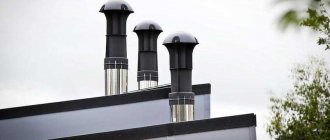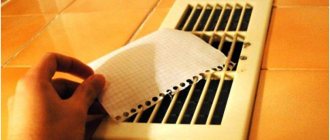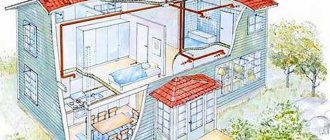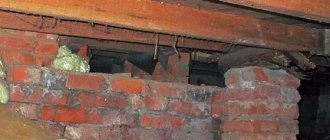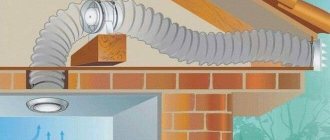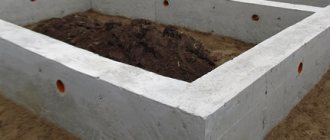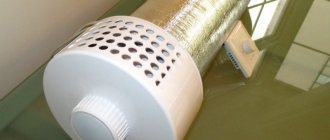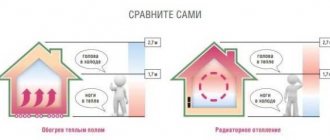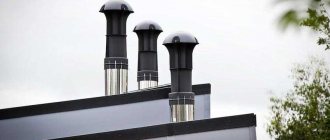An unpleasant surprise for homeowners is the appearance of unpleasant odors in the kitchen, bathroom, toilet, and then throughout the apartment. Almost immediately, cause-and-effect relationships are established: due to the occurrence of reverse draft, air flows from the ventilation vent connected to the ventilation duct - an element of natural ventilation of the apartment or house.
Many residents solve the problem simply: they seal the ventilation windows or install mechanical plugs that open as needed: cooking starts in the kitchen - the device opens, ends - it closes. The method works by removing emerging odors. But in this case, apartment dwellers are in for an even bigger surprise: stale, waterlogged air appears in all rooms. As a result, family members develop problems with the respiratory system, and mold and mildew begin to grow rapidly on the walls in different places.
The solution to the problem is completely different: you need to block the path of air flow from the hood, maintaining a free exit of air from all rooms of the living space. The problem is solved by installing a check valve for ventilation. The method does not require changes to the existing air exchange scheme or significant financial expenditure.
To get a positive result, you need to know how a ventilation check valve works, its design features, pros and cons, and installation features.
The editors of the StroyGuru portal have prepared material with photos and videos explaining the principles of operation of the back draft valve for ventilation and how to install it with step-by-step instructions. In addition, it is discussed in detail how to make a check valve for ventilation yourself.
Before we take a closer look at the simple device, let’s find out the principle of organizing air exchange in apartments, which will allow us to understand the reasons for the occurrence of reverse draft and ways to combat it.
Reasons for the formation of backdraft
Any home must have an air exchange system. If this is not done, air with a lower oxygen content (homeowners use it to support life), high humidity and dust accumulates in the premises. Waterlogging, dust and gas pollution, increased concentration of carbon dioxide (exhaled) lead to the development of various diseases.
In wooden houses, the exchange function is performed by walls, windows and doors, where air is removed from the house through wood (it “breathes”) and micro-cracks. In apartment buildings, ventilation shafts are installed for these purposes, to which apartments are connected using ducts. Air intake is taken from “dirty” or damp rooms: bathroom, bathroom, kitchen. The system has two tasks:
- remove excess moisture and odors to the street;
- create a reduced pressure in the apartment to bring in fresh air from outside.
This air exchange system is provided by supply and exhaust ventilation. The “golden rule” of its operation is based on the principle: at any given time, the volume of air removed from the apartment must be equal to the amount of air supplied.
If this balance is disturbed and the total air flow from the housing is higher, backdraft from the ventilation occurs. Experts name several reasons for this effect, grouping them by characteristics into external and internal. External reasons include:
- narrowing of the ventilation shaft. This effect is observed due to the settling of volatile fats (formed during cooking) on the walls of the channel, to which, in turn, dust adheres. As a result, draft overturning occurs on the upper floors of high-rise buildings: exhaust air enters the apartments;
- reducing the flow of clean air. Replacing wooden windows with metal-plastic ones disrupts the flow of air from the street - it becomes less. Under these conditions, the hood weakens. And, as soon as the temperature in any room with ventilation vents increases even slightly, for example, in a bathroom with a bathtub filled with hot water, the draft in it increases, and with it the volume of air removed increases. Compensation occurs due to the reverse flow of air from the ventilation duct in the kitchen or bathroom.
Internal factors include the installation of forced ventilation in the kitchen without taking into account the changing balance of inflow and outflow of the gas-air mixture, which leads to reverse draft (stray flow) in other rooms without ventilation.
You can give a dozen more reasons leading to the overturning of traction. But the examples given are enough to understand the essence of the difficulties that arise.
Why do you need a check valve for ventilation?
The problem of backdraft from ventilation can be solved in two ways:
- install forced supply ventilation, which, by creating excess pressure in the apartment, blocks return flows from the hood;
- use a check valve for ventilation in the apartment.
In the first case, financial investments are needed, which consist of the cost of the fan and the work required to install it, as well as constant spending of the family budget on electricity bills.
In the second case, you can buy an inexpensive, simple check ventilation valve, install it yourself and forget about the problem for many years. The device properly and easily passes air flows in one direction, outward. As soon as the flow weakens or changes direction, the shutter instantly blocks the ventilation duct. This is why a check valve is needed in ventilation.
Design and principle of operation
A ventilation check valve is most often a piece of round or square pipe. In this segment, a piece of material (metal, plastic, mica) of a suitable shape is movably installed - usually on an axis. This is the valve itself. When closed, it completely covers the cross-section of the pipe; when open, it should create as little resistance as possible. For everything to work correctly, you need to install it so that when a backflow of air occurs, the valve closes.
These are check valves for the air duct pipe
For ventilation, not only valves are installed in the pipe - there are options for a ventilation grille and a fan. In the case of a vent grille, a thin plastic or mica membrane can be used, which is attached to the grille. There is also a butterfly valve and blind-type slats. The reverse air flow valve on an exhaust fan can be of the same type.
Other options
The operating principle of this device is simple: during normal air movement, the valve is open and creates slight resistance to air flow. When reverse draft occurs, it closes, preventing the entry of foreign odors or cold air from the street into the room.
Principle of operation
The non-return ventilation valve is not a complex device. His work is based on the idea of building a shutter into the air duct, which can only allow flow in one direction. During standard air movement it is open, but when it stops or when counter flows occur, it closes. The device operates automatically, without human intervention.
Operating principle of a diaphragm valve.
This principle of blocking reverse thrust is embodied in several types of devices, each of which has varieties (modifications).
Types of check valves
In scientific and popular science literature, a check air valve for ventilation is classified according to many parameters:
- operating principle;
- device form;
- material of manufacture;
- installation method;
- control method;
- type of construction.
We especially emphasize that specialists do not always have a common point of view on the distinctive features of individual valve models that allow them to be classified into any classification group. Let's try to sort out the confusion.
According to the principle of action. In the classic version, all locking devices according to their operating principle are divided into gravitational and mechanical. The separation is based on the method of blocking the air channel. In gravitational devices, the shutter closes the channel under its own gravity. This ability appears in two cases:
- the sash fastening axis is fixed above the middle of the channel. As a result, when the air flow weakens, the heavier bottom falls, blocking the air duct;
- A small weight is attached to the bottom of the petal, acting as a counterweight. In this case, the location of the axle attachment does not play a significant role.
Reed check valve design. 1 - body with a flange connection (there is also a bell-type connection, when it is simply inserted inside) 2 - flap on an eccentric axis 3 - rim, to which the damper is pressed in the “closed” position 4 - damper mounting axis 5 - adjustment lever 6 - counterweight
With mechanical devices, the reverse thrust is blocked under the influence of springs on the sash.
But this classification does not include membrane devices that allow flow in one direction under the pressure of an air stream. There are two ways out of this situation.
- Add a third characteristic of the parameter: add a membrane principle to the gravitational and mechanical principles of operation.
- Replace the mechanical method of blocking the channel with a forced one, which will have two subtypes: mechanical and membrane.
According to the form. A forced or gravity check valve for ventilation can be round, rectangular or square.
Rectangular valve.
In residential construction, mainly round devices with a diameter of 100-125 mm are used. Rectangular and square systems are designed for public buildings and industrial production.
According to the material. The materials for the manufacture of locking devices can be plastic, galvanized steel and aluminum. Plastic models have become most popular among the population. They have many advantages:
- affordable price;
- light weight;
- silent operation.
Plastic valve.
The disadvantages include a shorter service life compared to metal counterparts and poor resistance to aggressive environments.
Industrial versions of the valve are made from metal. They are heavier and more reliable. But there are disadvantages: in the removed air there are various chemically active substances in a dusty state, which corrode the zinc, after which the process of oxidation of the steel starts (it rusts). And condensation settles on aluminum dampers.
Metal valves.
According to the installation method. The valve can be mounted horizontally or vertically. The need for such an installation is dictated by the design of the air duct and the type of ventilation: supply or exhaust. At the same time, only devices with a forced operating principle operate in a vertical position.
Control method. The shutter control can be:
- automatic - the position of the damper is determined by the strength of the air flow;
- manual - adjusted by the homeowner using a valve, valve or lever. Used in natural ventilation of both types (supply and exhaust);
Locking device with manual adjustment.
- electric - the volume of air passing through the duct is controlled using touch sensors operating in the same system as the fan.
Type of construction. Structurally, the check valve can be: membrane; petal; butterfly; lattice.
In the membrane version, a very thin flap (membrane) is attached to the valve outlet, which opens the outlet from the device channel at the slightest breath. When the flow direction changes, it is pressed tightly against the grid, which fixes its stable position.
Diaphragm valve.
You can make such a locking device yourself. To do this, on the back side of the ventilation grille, to its top, you need to glue a thin lavsan or food grade polyethylene film, cut to the shape of the channel, but slightly larger. During exhaust, such a damper perfectly allows air flow to pass through, and when reverse draft occurs, it sticks to the grille, blocking the exhaust hole.
In a reed valve, a rigid flap is mounted on an axis on which it rotates freely through 90o, but only in one direction. In gravitational types of devices, the center line passes above the center. Thanks to this, the channel opens under the pressure of the flow. When changing the direction of movement, it closes - the lower part of the damper lowers under the influence of gravity. This valve model can only be installed in a horizontal position.
Reed valve.
In mechanical locking systems, an electric motor or magnets open and close the damper. A standard technique: a loss of power supply lowers the damper, blocking reverse flows. In case of a power outage, manual adjustment of the damper position is provided. Can be installed in any position: horizontally, at an angle, vertically.
In mechanical valves there is an option, although not very popular, when instead of one petal two are used. This is the so-called butterfly. Sometimes they say "cracker". The principle of operation is the same as that of a device with one plate: under air pressure, the petals fold like the wings of butterflies, opening the way for the flow. When the pressure is released, the plates return to the “closed” position under the influence of counterweights or springs. Such systems only work in a horizontal position. Minus - they do not open with low air flow.
Butterfly valve with springs.
An inertial ventilation grille with a check valve (also called “blinds”) is a gravitational type of device. It is installed either at the outlet of the ventilation duct, i.e. on the roof - prevents the draft from being overturned by the wind, or in a ventilation duct with forced air supply. In the apartment, the force of the air flow is not enough to open several plates mounted on hinges parallel to each other.
Inertial ventilation grille.
Types of return devices
The following types of check valves are used in room ventilation systems:
- air dampers - gravity and spring;
- petal (membrane);
- double-leaf butterfly type.
The elements are made of plastic, aluminum alloy, galvanized or stainless steel. Some have combined models - a metal body, a plastic sash.
Galvanized dampers are used primarily in industrial ventilation systems. They are used to cut off the reverse flow or regulate the amount of air - manually or using an electric drive, shown in the photo. Plastic ventilation fittings are used indoors, stainless steel – outdoors.
Addition. Check valves also include ventilation grilles with horizontal rotating louvres. The principle of operation is similar - under the influence of gravity, the rectangular doors close, preventing outside air from entering the channel.
Let's give a short commentary on the video. Not all the master’s words correspond to reality, but he does one thing right: he installs an external grille with gravity doors.
Design and principle of operation of dampers
A single-leaf check valve consists of the following parts:
- round or rectangular body;
- a damper is attached to the inside of the walls, which rotates freely on a transverse axis;
- in the closed position, the sash is held by a spring (not present in gravity models).
The axis of rotation of the spring-loaded damper coincides with the longitudinal axis of the pipeline, the normal position is closed. After the fan starts, the shutter opens under the pressure of the air flow, and when switched off, it automatically slams shut. Closing is accompanied by a characteristic sound, hence the second name of the valve – “clacker”.
The double-leaf “butterfly” is designed identically, but instead of one damper, 2 are used, the spring is installed in the middle. Both types of ventilation valves are capable of operating only in forced ventilation systems. The natural draft pressure is not enough to open the spring-loaded sash.
Shut-off flappers as part of other ventilation accessories - connectors and mounting plates
In single-leaf gravity dampers, the damper rotation axis is located eccentrically, that is, it is shifted above the axis of the air duct. Thanks to this, the larger half of the sash outweighs the smaller one, which is why it closes without any springs. Correct installation of the check valve plays a role here:
- if you insert the element into a horizontal pipe according to the instructions (the axis of rotation is above the center of the duct), the damper will close immediately;
- if you turn the ventilation valve upside down, the passage will remain open;
- when installed on a vertical channel, the closure of the sash also depends on the position of the element.
The firecracker for natural ventilation is placed in 2 ways: horizontally in a closed state or vertically, but with an upward flow. In other positions, the behavior of the valve is difficult to predict; if a reverse air flow occurs, the valve may not work.
Scheme of operation of the flapper valve. Due to the upward movement, the free sash automatically closes
Household "firecrackers" can be part of other ventilation accessories - connecting nipples, wall flanges. There are also exhaust fans with a check valve - “butterfly”.
Diaphragm Valves and Gravity Screens
In products of the first type, the function of the main shutter is performed by a membrane made of a thin polymer film adjacent to the body or the slots of the ventilation grille from the inside. The film is attached to the central axis of the valve, the edges remain free.
Under the influence of natural draft or fan pressure, the outer petals of the film bend, allowing air to pass through. When the gases move back, the lavsan membrane again adheres to the frame, blocking the passage. Leaf type valves can be included with exhaust fans and grilles.
Note. It’s easy to make just such an air valve with your own hands. It is enough to attach 2 film petals to a regular grille, pressing them with a cardboard spacer with cutouts. Manufacturing instructions are shown in the video below.
Multi-leaf grilles operate on the principle of dampers, which lower under their own weight. Scope of application: forced ventilation exhaust ducts ducted outside through walls. Natural draft does not occur in horizontal pipes.
Recommendations for selection
There are so many types, types and varieties of valves on sale that you can be stumped: what to buy? Knowing the selection criteria will help you decide:
- the shape and size of the device must fit freely into the existing ventilation hole (duct). Therefore, before going to a retail outlet, it is necessary to take appropriate measurements of the hood: determine the diameter if the duct is round, and the width and height if it is rectangular or square;
- the material from which the devices are made. For household needs, the best option is plastic. Metal is purchased only in two cases: there is a membrane or damper with an electric drive or manual control;
- for natural exhaust ventilation, dampers are needed that open under weak air pressure: membrane or gravity with one blade;
- with weak draft, effective air exchange is possible only with forced ventilation. The fan can be installed both on the supply side - excess pressure in a private house or apartment will be vented into the exhaust duct - and on the exhaust hood. But with the second option, it is necessary, firstly, to install shut-off valves on other exhaust windows, and secondly, to check with the management company about the capabilities of the mine, so as not to create an excess volume of air flow - it will end up in the apartments located above. For example, if you install a check valve with an electric drive for ventilation in the kitchen, then the likelihood of reverse flow entering the toilet and bathroom not only from the ventilation shaft, but also from the exhaust kitchen air of your own apartment increases;
- The valve capacity (denoted by Kvs, measured in m3/hour) should be:
- for the kitchen - 60-90 m3/hour;
- bathroom - 25 m3/hour;
- toilet - 25 m3/hour;
- combined bathroom - 50 m3/hour. Data on the volume of air passed through during natural draft are indicated in the passport.
- installation location - many devices do not work in conditions of negative temperatures, for example, “butterflies”.
Purpose of ventilation dampers
This problem is especially typical for kitchens, bathrooms and bathrooms. Here you cannot do without special design elements - ventilation dampers.
In addition to eliminating reverse draft, the damper can solve a number of related problems:
- Eliminates drafts.
- Prevents insects from entering from the ventilation shaft.
- Reduces dust concentration.
Another important function of ventilation dampers is to provide fire protection by preventing the spread of open fire and combustion products through the ducts of the ventilation system.
Choosing an installation location
Choosing the correct location for installing the check valve is possible only if a number of requirements are met:
- when taking exhaust air in one place, regardless of whether it is connected to the shaft or goes outside, it is enough to install one valve at the inlet;
- with a branched exhaust ventilation system - there are several independent hoods or windows of one channel - they do this: a check valve is installed at each intake point. This technical solution prevents redirection of air flows, especially if there is an active hood in the kitchen. To be on the safe side, in private houses and cottages they install an additional check valve at the outlet - it prevents the draft from tipping over in strong winds;
Louver valve for installation at the ventilation outlet.
- In apartments, the check valve is installed on the wall; in cottages, installation on the ceiling is allowed. Such requirements are explained by the need for regular maintenance of the device - the damper must open/close easily, but grease and dust interfere;
- It is better to install a check valve on the supply and exhaust ventilation in the apartment, eliminating the slightest possibility of the damper freezing.
The presence of different ventilation schemes does not allow this article to consider in more detail the issues of placing a check valve in the kitchen, bathroom, and toilet. This requires separate material.
Overview of types of ventilation valves
The types of ventilation valves are varied: air, check, changeover, with or without insulation, fire, sewer, electric, throttle, hermetic, etc. The article contains information about each type of ventilation valve.
Some types of ventilation valves in the photo
Main types of ventilation system valves
- Ventilation check valve. Its cross-section can be round or square. It is needed to prevent air circulation in the duct when the fan is not running. Read more about this type of valve at the link.
- Air ventilation valve. Regulates air flow and blocks it in case of fire. Carbon monoxide does not enter the ventilation system, because the valve closes if there is a fire. There are many models of air valves. Operating temperature: maximum 80 degrees Celsius.
- Changeover valve for ventilation. It can only be installed vertically, where the pressure is no more than 1500 Pa and the air flow speed is up to 20 meters per second.
Allows you to turn on an additional exhaust device in the event of a breakdown of the main one. Used where ceilings are higher than 3 meters. The valve consists of a body and a blade with bearings. It opens when air flow acts on it.
The valve can be installed horizontally (assuming an air flow speed of 6 meters per second) or vertically (assuming an air flow speed of 4 meters per second). The design includes blades located on axes.
Overpressure
The valve maintains the level of pressure in the room determined by the designers and forces the air to move unidirectionally. If necessary (a nuclear war has begun, a bomb with toxic substances has exploded, etc.), the device can make the room airtight. Excess pressure causes the valve to open. When it is set at the desired level, the eccentric closes the valve.
Overpressure ventilation valves are used to regulate room pressure
Our website contains reviews of other elements of the ventilation system. Read about the types and manufacturers of flexible air ducts:
Electrically driven
The electric drive automatically opens and closes the damper.
Most supply ventilation systems have an electric valve. In exhaust systems, a valve without power supply is usually used.
Disc-shaped
A plastic poppet valve is suitable for supply and exhaust ventilation in an apartment.
Insulated
KVU - insulated air valve - is installed in systems with a pressure drop of 1800 Pa. You can open the KVU not only manually, but also remotely: it has an electric drive. The aluminum blades rotate and the air volume is adjustable. The valve is insulated with electric heaters, so the blades open easily even in winter. Can be operated at temperatures of -70 degrees Celsius.
Natural ventilation valve
Fläkt Woods produces valves for natural ventilation. They are attractive in terms of design and make virtually no noise during operation.
One of the types of valves for a natural ventilation system in a private house
Throttle
The throttle valve is made of thin galvanized sheets. It has a damper and a sector that controls its movement. In homes, it is not recommended to install a throttle valve larger than 50 cm in diameter, as there will be a lot of noise from the operation of the device.
Sewer ventilation valve
Several years ago, vent valves were developed to allow air to flow into the drain and trap exhaust air in the system when drainage is minimal.
Hermetic
A hermetic ventilation valve is installed in air exhaust systems as a shut-off device. It cuts off the flow of air into the room from other rooms and from the street.
In addition to ventilation, sealing valves are used in exhaust gas piping
Adjusting
KVR regulates the intensity of air flow into the ventilation system. The valve is also used in heating and air conditioning systems, the pressure in which does not exceed 1000 Pa.
The valve has 5 rotary blades, electric or manual drive. It can function as an opening and closing device and as an air quantity regulator. Flexible ducts are used in all modern ventilation systems: find out more about them here.
Inertial
It is used in supply and exhaust ventilation systems as a check valve. The air flow passes through the valve, opening its petals. The petals close when the ventilation system is turned off. The inertia valve is made of aluminum (profiles) and polyamide (fixing elements) and can be equipped with heaters.
Air
Electrically driven
VKA 150 is made of galvanized steel. There are seals inside the valve that guarantee its tightness. You can buy the device for 1,430 rubles.
Modern air valve for ventilation system with electric drive unit
Air valve for ventilation in the apartment
KIV-125 is used to organize the flow of air from outside into the room. Unlike valves that are installed in windows, KIV-125 does not make the installation of double-glazed windows more complicated and expensive.
Fresh air valve
In the wall
The supply ventilation valve KIV-125 is a meter-long plastic pipe. Its diameter is 133 millimeters. The length can be reduced according to the wall thickness.
The noise- and heat-insulated device is mounted in the outer wall. On the street it is covered by bars. There is a damper and filter on the pipe indoors. The supply ventilation valve in the wall works similarly to a window vent.
For plastic windows
The window valve is invisible only if it allows a small amount of air to pass through. If the valve provides a large air flow, then the device is large and expensive. There are also plastic ventilation ducts.
The picture shows the principle of operation of the supply ventilation valve on plastic windows
KPV-125
With the help of KPV-125, just like with the help of KIV-125, the air supply to the room is regulated without the appearance of drafts in it. The valve is mounted in the wall and is effective even if the outside temperature is very low.
A supply wall valve for apartment ventilation supplies air from the street, preventing dust from entering the room and soundproofing it. Turning on the minimum mode maintains a normal microclimate in the apartment during the departure of its owners.
To prevent ventilation from losing its effectiveness in summer, you can install a ventilation valve with a recuperator.
Valve KPV-125 and its elements in the photo
Fireproof
- Fire retardant (fire retardant). Mounted in general ventilation systems. Initial position - the valve is open. The OZK valve for ventilation is designated by the letter O, which means “normally open”. They trap the fire, preventing its movement through the ventilation system.
- Smoke. Installed in an anti-smoke ventilation system. Initial position - the valve is closed.
Fire retardant
To ensure the safety of people indoors during a fire, fire-fighting and fire-retarding valves are installed in ventilation systems. For example, "BUG". Such valves prevent fire from spreading through veterinary systems. The valves are equipped with devices that allow them to operate automatically if necessary. Pay attention to fire-resistant air ducts when arranging the ventilation system.
Appearance of fireproof ventilation valve
Exhaust
- KGEB. The exhaust device can be mounted either on the ceiling or on the wall. Works quietly, even if the system pressure is high.
- GPDF/B. Exhaust type valve. Installed on the wall or ceiling. Can be mounted on a spring or on a mounting frame.
- KGEA. Ventilation exhaust valve into the wall. The operation of the KGEA can be adjusted using a nylon cord.
- KK. Mounted on the wall or ceiling. The sizes are different.
Wall-mounted exhaust valve for ventilation
Automation of ventilation valves
The control of ventilation valves can be automatic. Electric drives make it possible to open and close dampers. There are 2 types of electric drives: electromechanical and electromagnetic with a spring. The second type closes the valve even if there is no power supply.
CO2 sensor
The QPA1000 CO2/VOC sensor shows the concentration of carbon dioxide, smoke, flammable gas and organic vapors in the air. It is installed in different rooms (in rooms, exhibition halls, catering premises, museums, sports complexes and other buildings where air quality control is necessary).
Carbon dioxide converters in the ventilation system
Ventilation units can not only regulate the flow of air into the room, but also control the level of CO2 in the room, cleaning the air in it without interruption and maintaining a good microclimate.
Haven't started organizing your ventilation system yet? Find out about the benefits of galvanized air ducts in our article.
Ventilation system valve cost
In RoomKlimat, a check valve RSK with a seat diameter of 100 mm costs 192 rubles, 160 mm - 315 rubles. The valves have a rubber seal. The larger the diameter, the higher the cost.
The price of a valve with a manual drive is at least 1034 rubles. The control valve costs 1520 rubles (99 mm). A device with an electric drive — 2203 rubles (minimum). Valve for electric drive - 1224 rubles (100 mm).
Where to buy a ventilation valve?
In Moscow:
- "Sigma", address: Andronovskoe highway, 26, building 1, phone: +7 495 989-42-20.
- Supervent, address: st. Okskaya, 13, warehouse address: st. Mashinostroeniya 2-ya, no. 29, tel.: tel..
- "Flekt Industrial & Building Systems", representative office address in Moscow: st. Profsoyuznaya, 23, tel..
- “VentComfort”, address: Projected passage 5112, phone: +7 (495) 646-72-35.
- "GK Lakom", address: st. Nizhegorodskaya, 102, tel.: +7 (495) 77-55-405 (multi-channel).
In St. Petersburg:
- "Climatic Holding", st. Tkachey, no. 5, room. 8-H, tel.: +7 (812) 995-88 - 10,.
- Supervent, address: Krasnogvardeisky lane, 15, tel.: (812) 495-61-96.
- "VentComfort", address: st. Latvian Riflemen, 31, tel.: +7 (812) 309-27-86.
- “Petrovich”, sales office address: Leninsky Ave., 91, base addresses: st. Salova, 46; st. Planernaya, 15 v; Engels Ave., 157 A; Murmansk highway, 12 - 13 km; Moskovskoe highway, 304; Tallinskoe highway, 131; Industrialny pr., 73, tel.: 8 (812) 334-88-88.
Video
In order for the ventilation system to work efficiently, without interruptions, a ventilation valve is installed. Using it you can control the operation of ventilation.
Sep 1, 2015ventsyst
Installation instructions
To install a check valve for ventilation with your own hands, you will need:
- the valve itself;
- dowels with self-tapping screws;
- electric drill;
- perforator;
- silicone sealant.
Correct order of work:
- the equipment is checked (the list is given on the insert), although this is best done during the purchase process;
- the fan, if standing, is dismantled;
- the new fan is installed in place;
- marks are made on the wall for fasteners;
- Using a hammer drill, a groove is cut out in the wall for electrical wiring. The channel can be replaced with a plastic box or retro wiring, which, on the one hand, looks impressive, on the other hand, is expensive, and the wiring can be done directly along the wall;
- use an electric drill or hammer drill to drill holes for dowels;
- the fan is inserted into the air duct and fixed with self-tapping screws;
- wiring is connected;
- the connection between the fan and the wall is sealed with silicone sealant (some sets provide a rubber seal for this purpose);
- the operation of the fan is checked;
- At the fan inlet, a mesh is first installed, and then a check valve is installed for ventilation. If it is gravitational, check the horizon of the damper axis - if it is deflected, the petal may not close;
- the operation of the system as a whole is tested;
- a decorative cover is installed.
No instructions are needed to install valves at natural draft collection points. Everything is extremely simple there. The work progress is described in the instructions printed on the insert.
Valve installation diagram for natural (petal) and forced (butterfly) draft.
Epilogue
Let someone say that installing a check valve on ventilation is an extravagance that is not worth wasting time and money on. But still, many of those who have done this work claim that the air exchange in the room has improved significantly after this. Humidity has decreased, foreign odors have disappeared, etc. Based on the reviews, we can confidently say that a check valve for ventilation is worth installing. After all, our health depends on what we breathe, which means any improvement aimed at cleaning the air will be beneficial.
Check valve for forced ventilation in section
In any case, it won’t get any worse from installing such valves, which means it’s worth trying, to begin with, at least installing a valve made by yourself, because it won’t cost anything. Well, after understanding the advantages of such equipment, you will probably want to purchase a more advanced product manufactured at the factory.
Is it possible to make a check valve with your own hands?
Why buy a check valve when you can make it yourself. Of course, not electronic, but working effectively. How to make a check valve for ventilation with your own hands has already been discussed above (primitive membrane).
The second valve option is a modernized “butterfly”. You will need:
- decorative ventilation grille;
- a sheet of thin, soft plastic, like film from a fluorographic apparatus;
- knife or scissors;
- hot glue gun.
The film is cut so that its shape can completely cover the inlet hole in the grille. In this case, IMPORTANT, small ears are left in the middle on both sides, for which the future shutter will be glued to the grille body. After this, the plate is bent exactly in the middle by 45° and glued. You can’t bend it completely, otherwise it won’t close. The grate is put in place. The valve is ready.
One of the options for a homemade valve.
This same idea can be framed differently. Cut a rectangular sheet of paper in the middle. Glue the edges to the grill. The principle is clearly visible in the photo below.
Homemade check valve.
Similar systems were installed in Rus' in the chimneys of Russian stoves to prevent frost from creeping into the house in winter.

